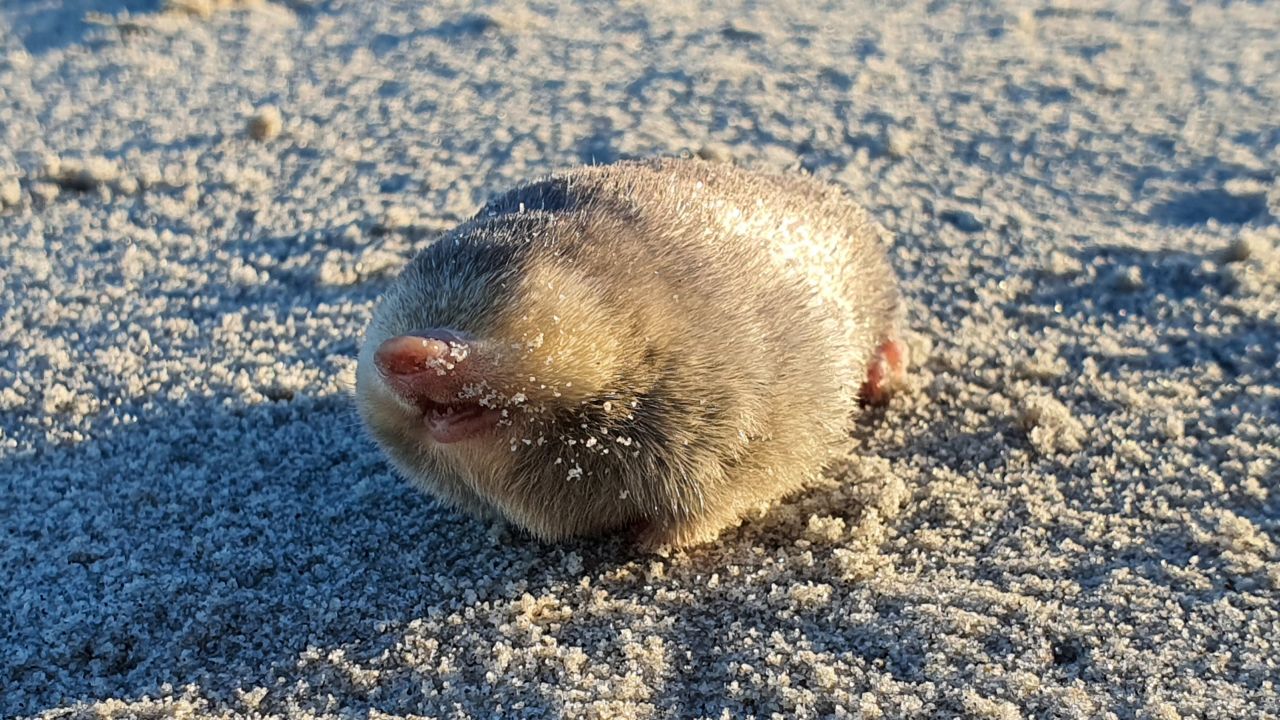Overview
In the vast dunes of South Africa, a De Winton’s Golden Mole, unseen for more than 80 years, has been rediscovered. This blind creature once thought to be extinct, was finally captured on film and in photographs following an extensive search by researchers. Last seen in 1936, it had slipped away from the scientific gaze, according to the dedicated researchers involved in this remarkable find.
What is the De Winton’s Golden Mole?
De Winton’s golden mole (Cryptochloris wintoni), a member of the Chrysochloridae family, is a mammalian species exclusive to South Africa. It thrives in subtropical dry shrubland, Mediterranean-like shrubby surroundings, and sandy shorelines. Unfortunately, its habitat faces peril from destruction, rendering it critically endangered, according to the International Union for Conservation of Nature (IUCN). The species was named in honour of the British zoologist William Edward de Winton.

It resembles Grant’s golden mole (Eremitalpa granti), featuring short, dense slate-grey fur with a yellowish hue on the upper parts. The claws on its forefoot, especially the third digit, serve as pointed digging tools, measuring about 10.5 mm in length and 4 mm in width at the base.
In 2017, De Winton’s golden mole gained notoriety as one of the 25 “most wanted lost” species in Re: wild’s “Search for Lost Species” initiative, having remained unseen since 1937. After an initial sighting in 1936, De Winton’s golden mole eluded observation for an astounding 87 years until its recent rediscovery. The IUCN has upgraded its status to “critically endangered.”

Like other golden moles, studying or visually tracking this species is challenging due to its subterranean habits. C. wintoni’s rarity exacerbates this difficulty, compounded by its striking resemblance to more commonplace golden mole species.
One fascinating feature of these elusive creatures is their oily secretion, creating an iridescent sheen on their fur. Despite the name “golden mole,” most don’t boast a golden hue. Blind by nature, they compensate with enhanced hearing capabilities, beneficial for hunting prey underground. What sets them apart is their remarkable navigation skills, guided by an advanced sixth sense that relies on remembering muscular activity patterns, known as kinesthesia.
How did researchers find the mole?
In their quest for the elusive mole, researchers adopted a meticulous approach, gathering over 100 soil samples from diverse locations. Their method involved scrutinising the samples for environmental DNA (eDNA), which comprises traces of the animal left in its surroundings through excretions, skin cells, and hair.
A sniffer dog played a crucial role in detecting traces of tunnels, ultimately leading to the discovery of a golden mole in 2021. However, given the existence of 21 golden mole species with strikingly similar appearances, the team faced the challenge of confirming whether it was indeed a De Winton’s.

In their pursuit of certainty, the researchers collected environmental DNA samples—genetic remnants animals leave behind in skin cells, hair, and bodily excretions. The turning point came in 2022 when a DNA sample of De Winton’s from decades past became available, courtesy of a South African museum. Upon comparing the DNA sequences, a definitive match emerged.
The culmination of the team’s exhaustive research and groundbreaking findings underwent a rigorous peer-review process, culminating in their recent publication.
The researchers’ journey to rediscover the elusive mole was no swift endeavour; it spanned three years from their initial expedition to the west coast of South Africa. The mole, known for its elusive nature, seldom left visible signs of its intricate tunnels, almost resembling a graceful “swim” beneath the sandy dunes, as described by the researchers. Golden moles, native to sub-Saharan Africa, presented a unique challenge in their quest, with De Winton’s species exclusively documented in the Port Nolloth area. The meticulous and patient efforts of the researchers ultimately bore fruit in the form of this remarkable rediscovery.

Samantha Mynhardt, one of the researchers, conveyed that they harboured high hopes for the discovery, but a few individuals dampened their optimism. She mentioned that a De Winton expert had expressed scepticism, stating, “You’re not going to find that mole. It’s extinct.”
Confirmation and photographic evidence of not just one but two of De Winton’s golden moles have been secured in Port Nolloth, according to Mynhardt. The research team’s efforts have led to the discovery of these individuals and the identification of signs indicating the presence of other populations in the area since 2021.
Esther Matthew, senior field officer with the Endangered Wildlife Trust, reflected on the project, describing it as highly exhilarating with its fair share of challenges. She expressed gratitude for having a remarkable team characterised by enthusiasm and innovative ideas, emphasising the necessity of such qualities when surveying up to 18 kilometres of dune habitat in a single day.
De Winton’s moles claim the 11th spot on the list of 25 “most wanted” lost species, successfully rediscovered by science. Through collaborative efforts with partners worldwide, Re: wild has achieved the confirmation of various species, including a captivating chameleon in Madagascar, the world’s largest bee in Indonesia, a holly tree in Brazil, and an elephant shrew in Somalia.
Conclusion
As monumental and joyous as the rediscovery of De Winton’s golden mole reminds us that our planet is a shared home for diverse species beyond humans, it underscores the interconnectedness of all living beings and our collective responsibility to safeguard the rich habitation of life on Earth. Each rediscovery is a celebration and a call to action, urging us to cherish and protect the biodiversity that makes our planet extraordinary.











